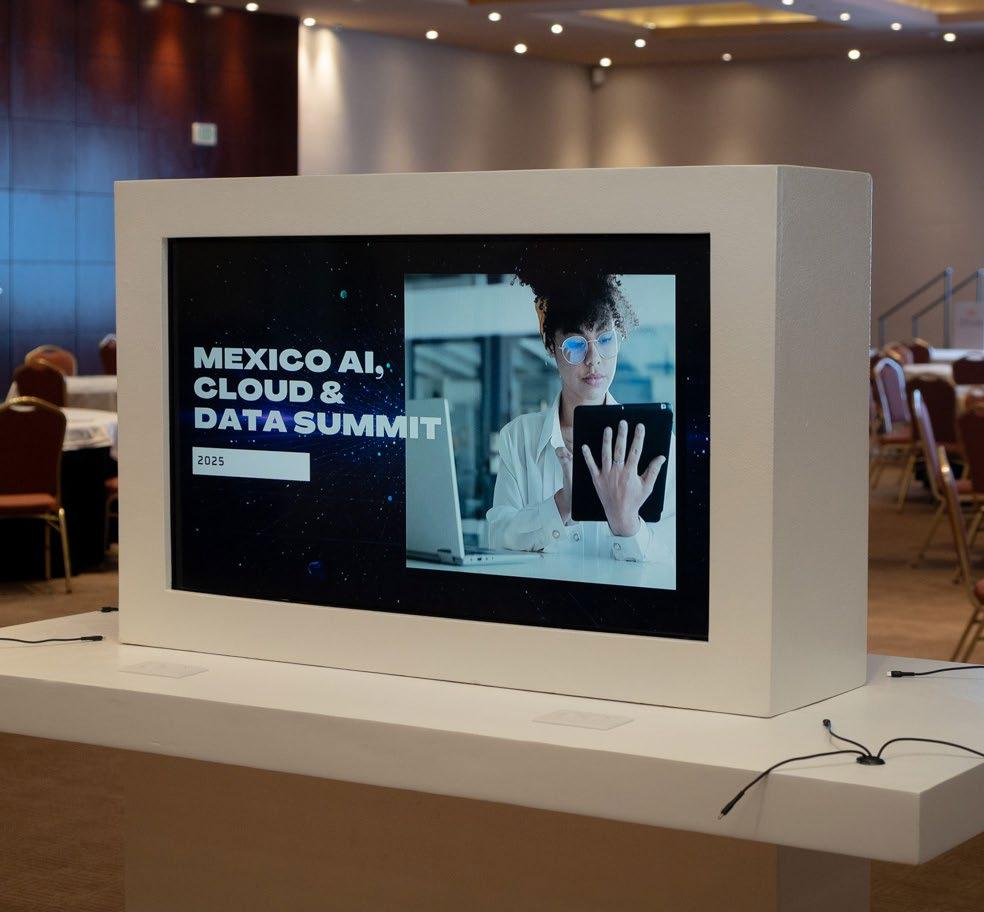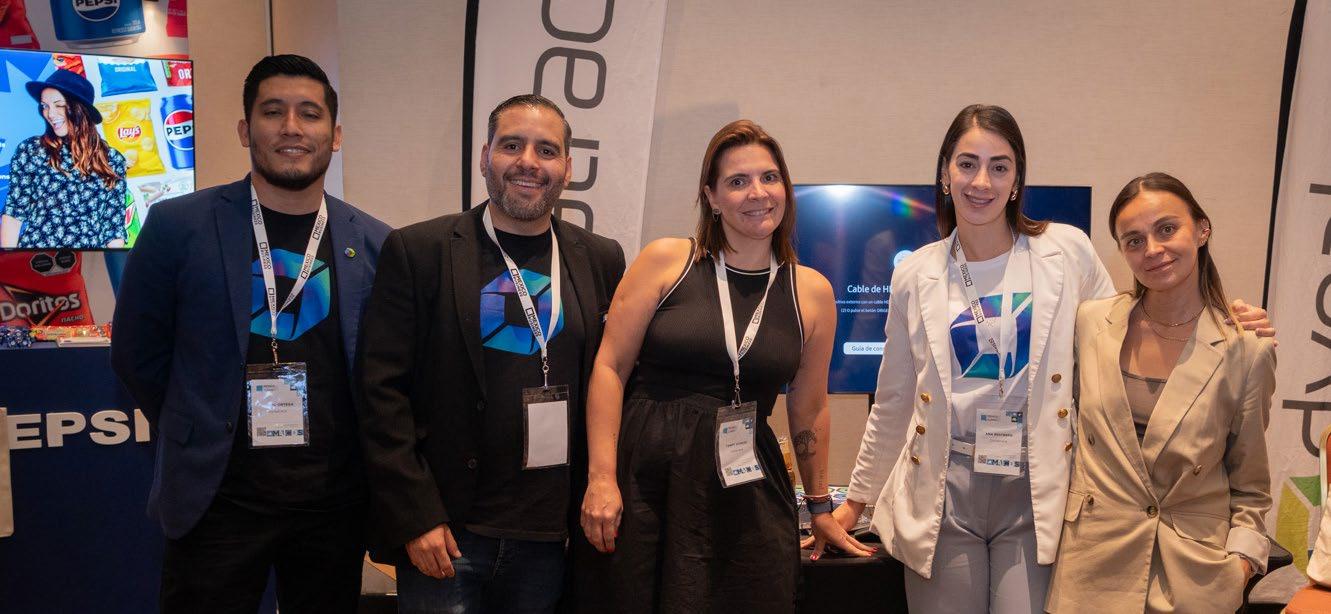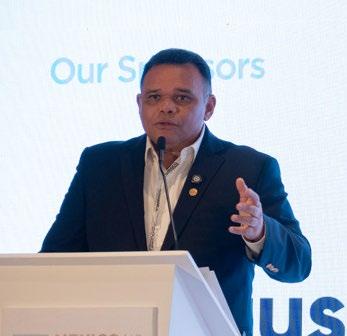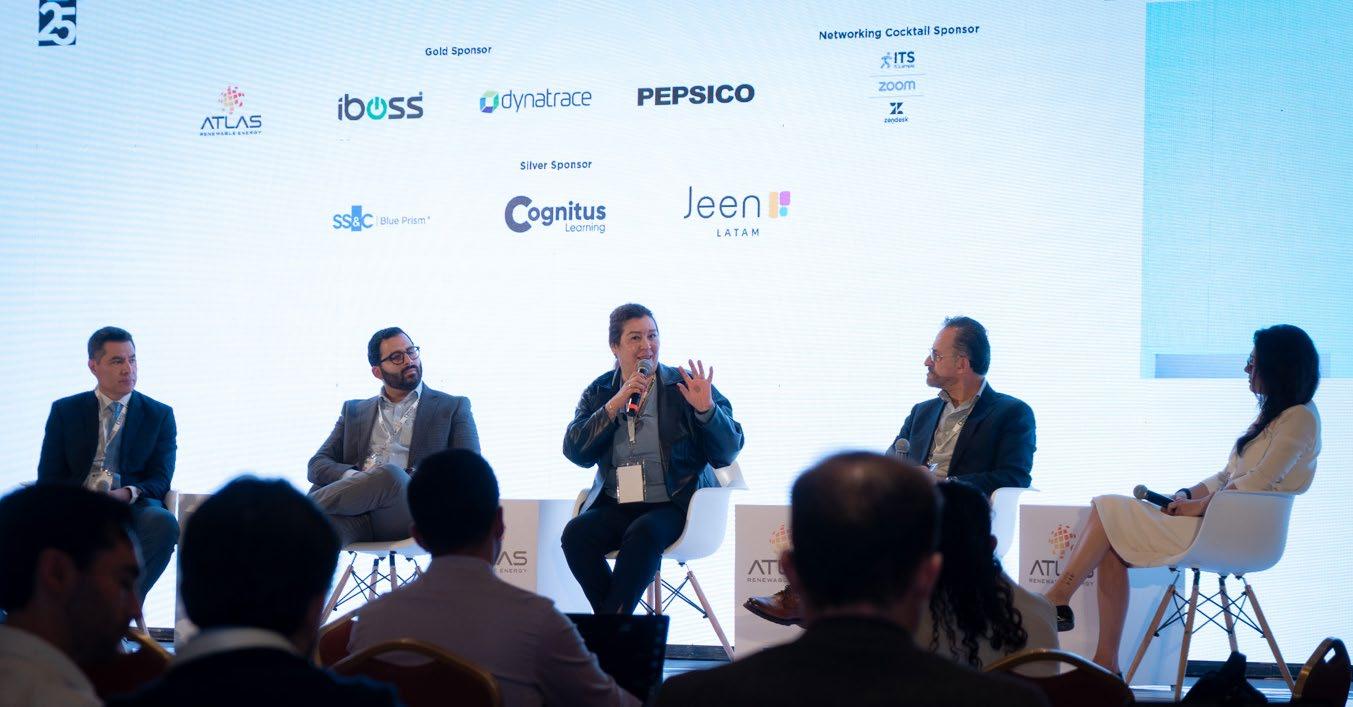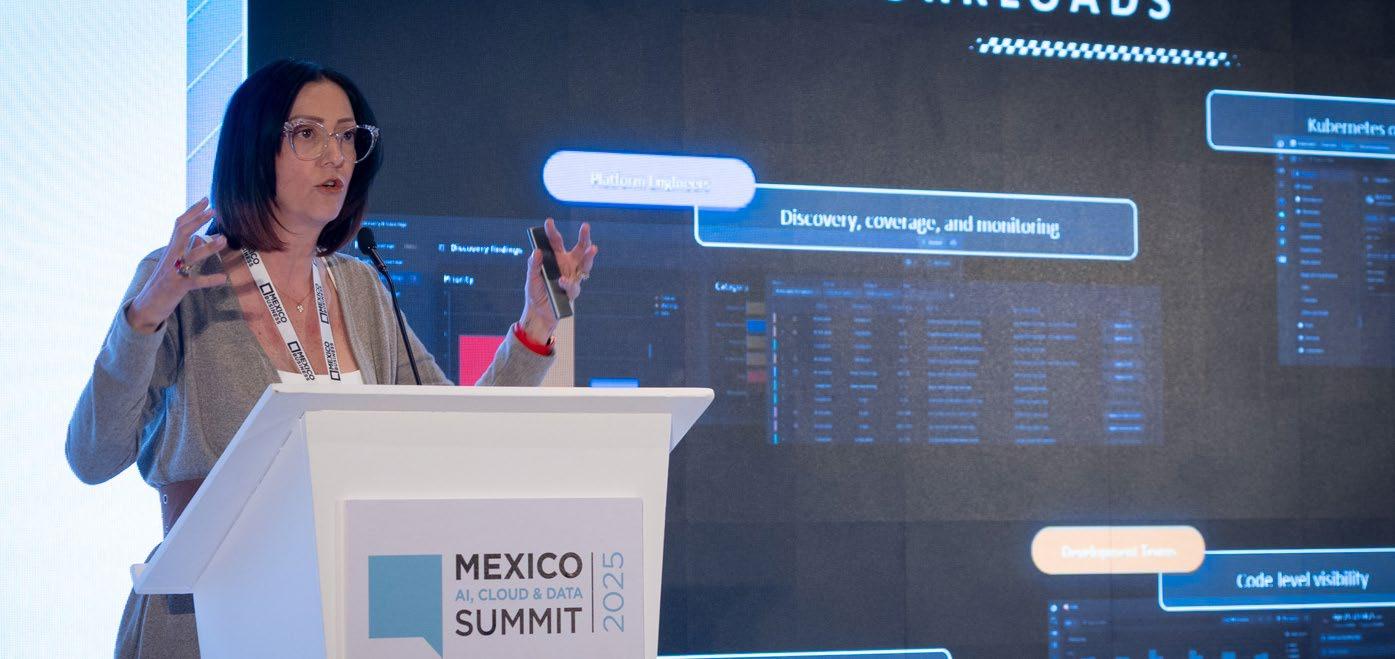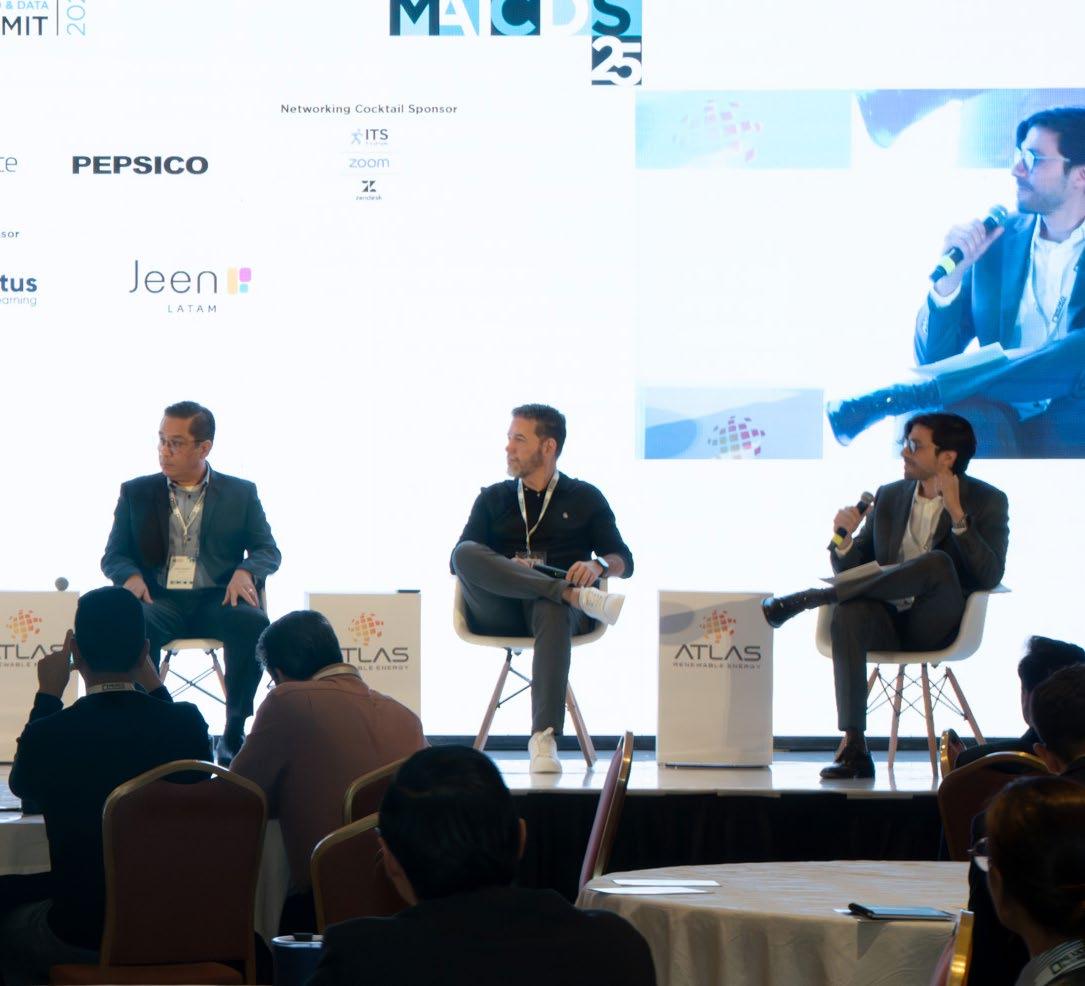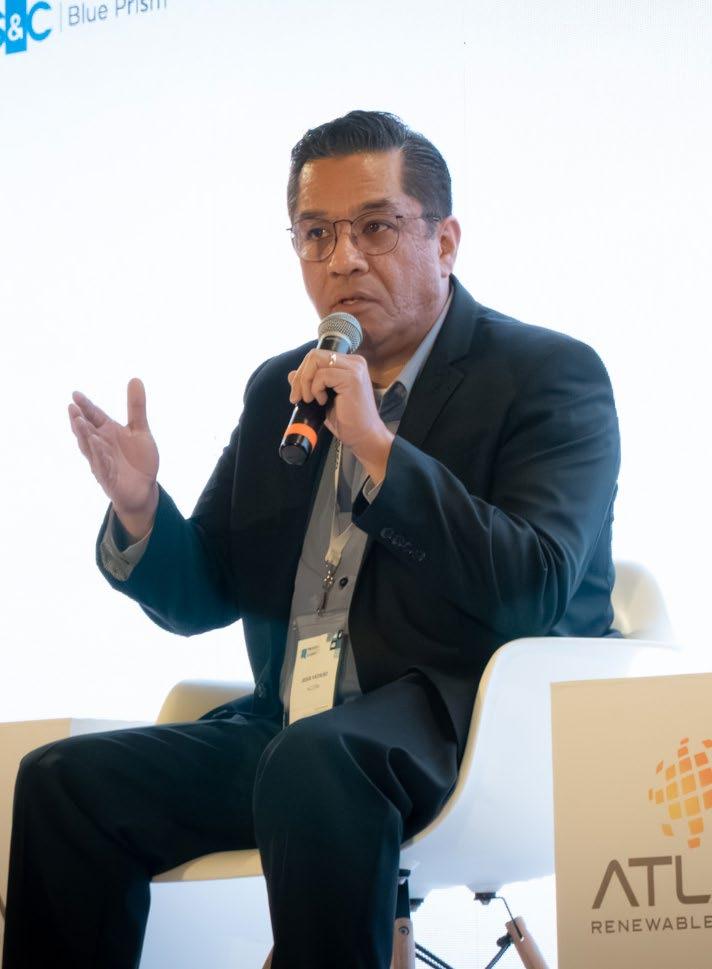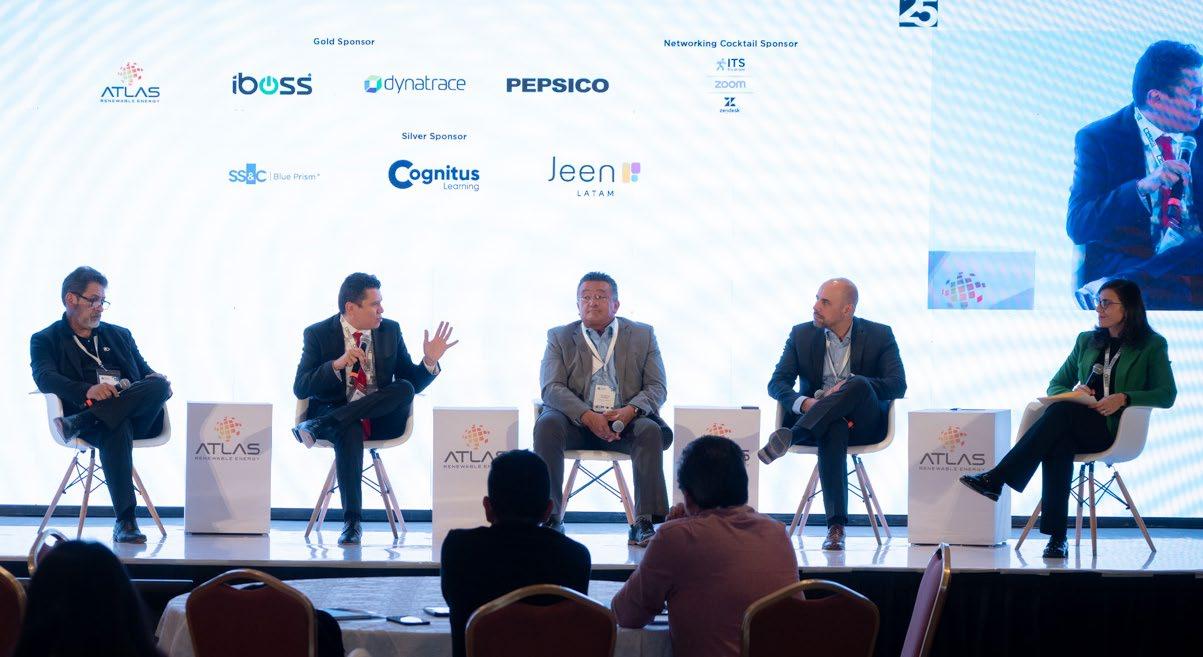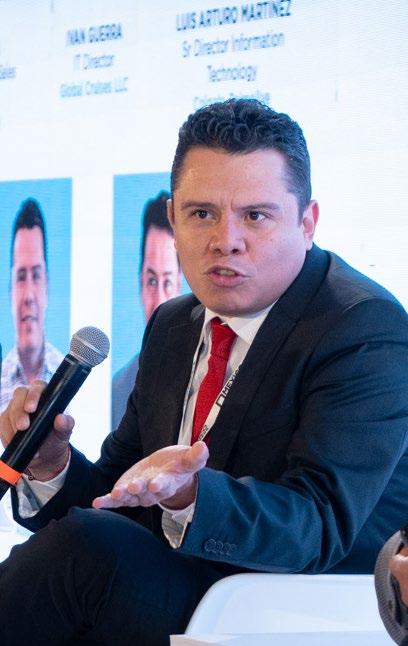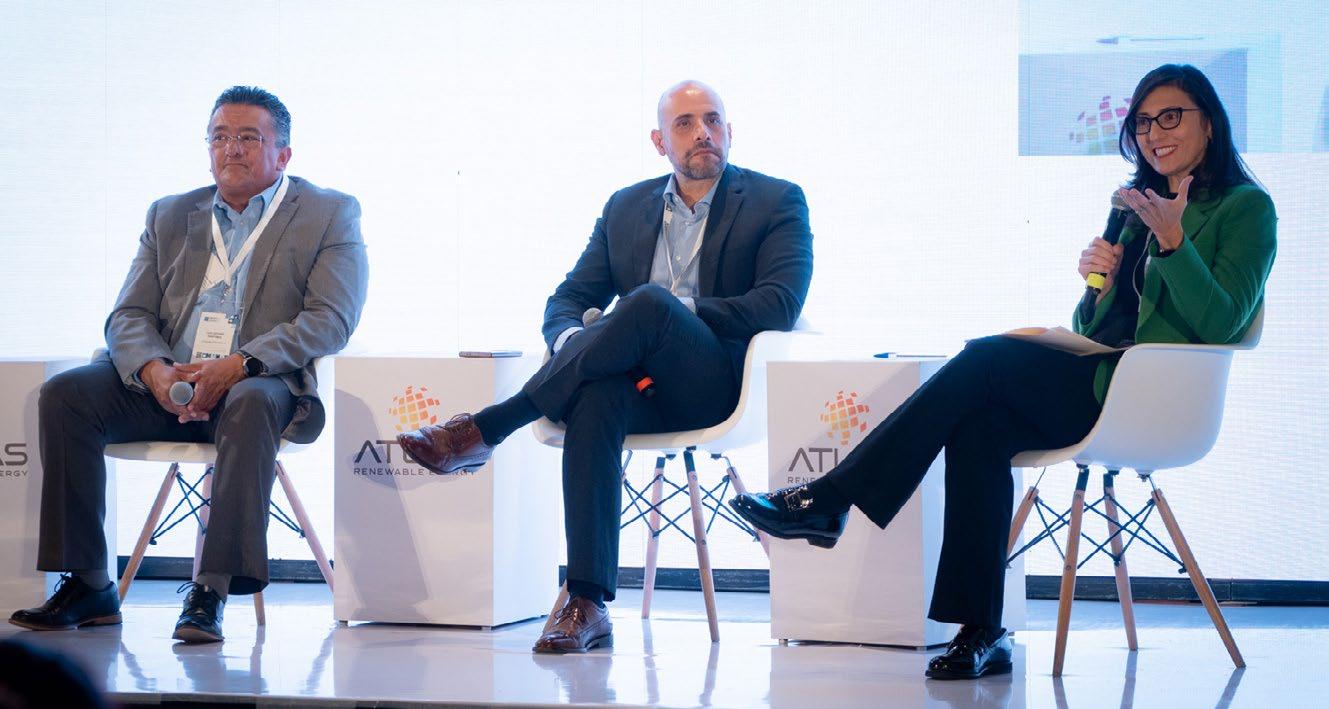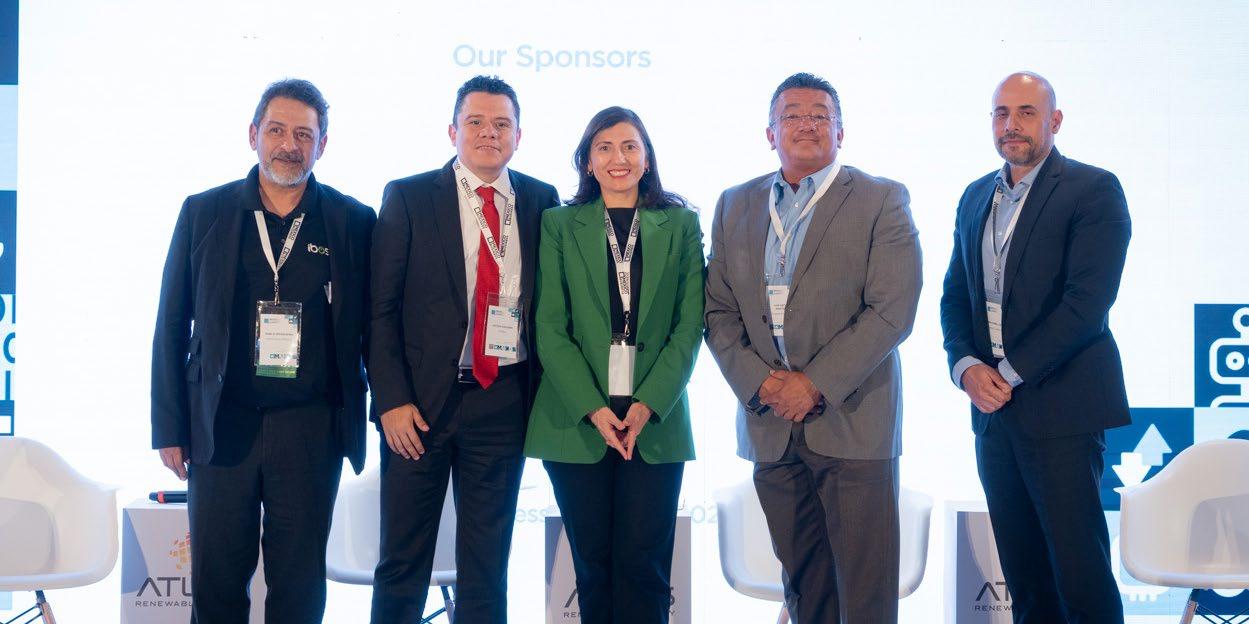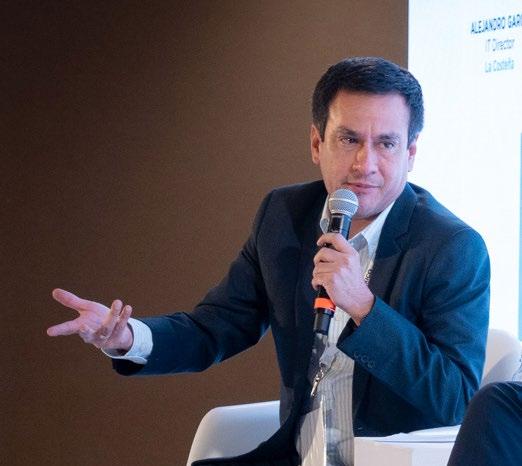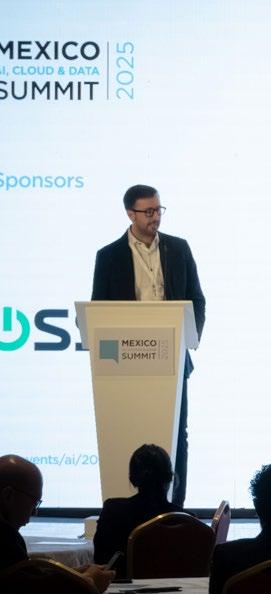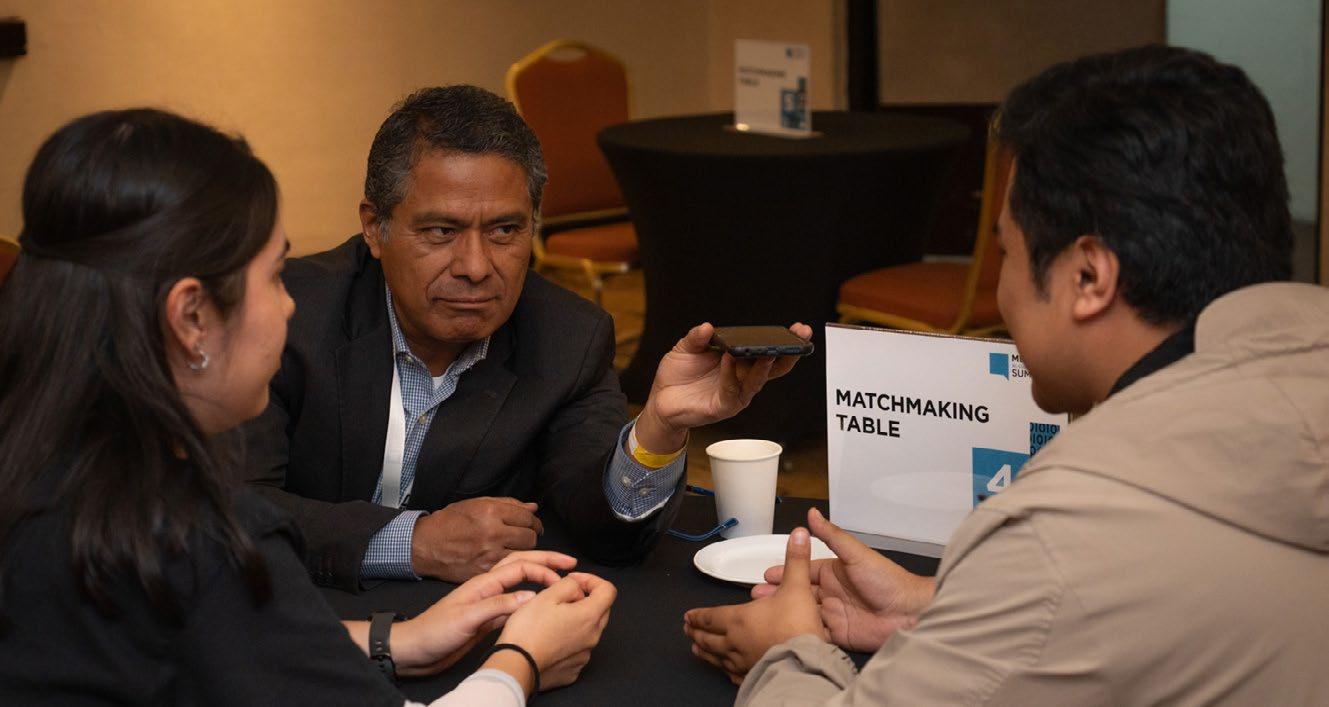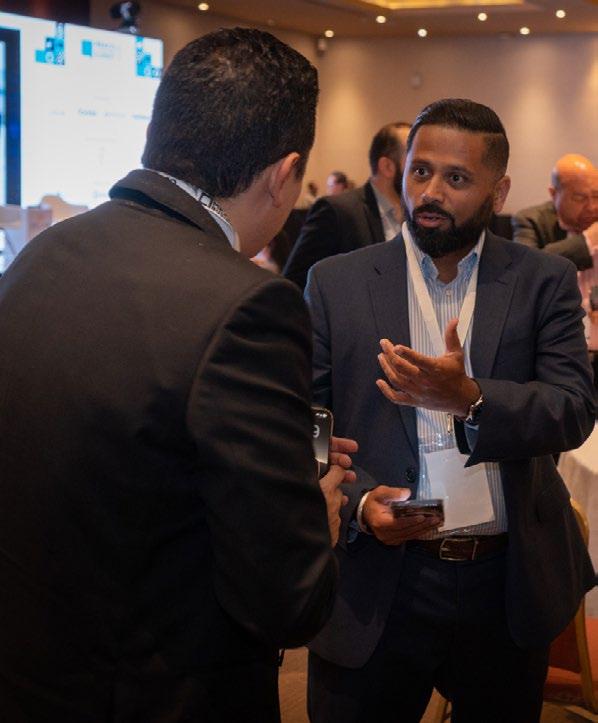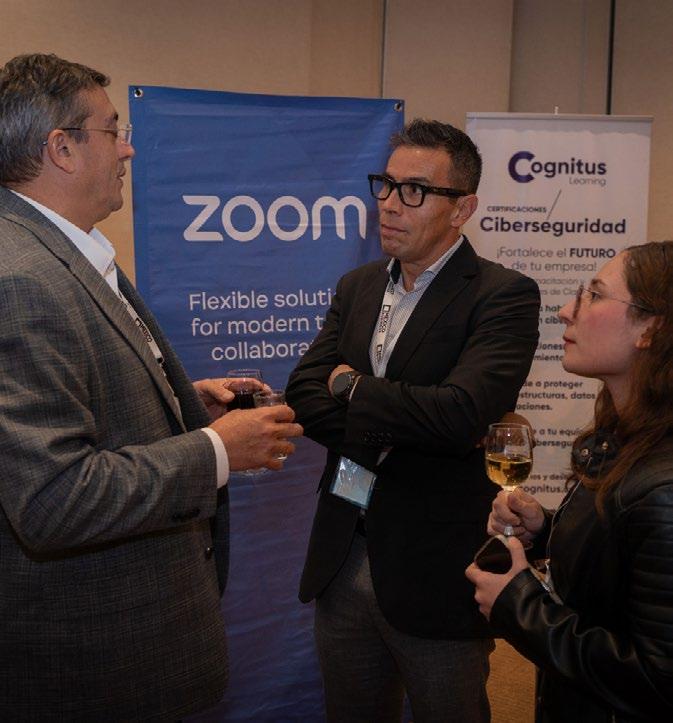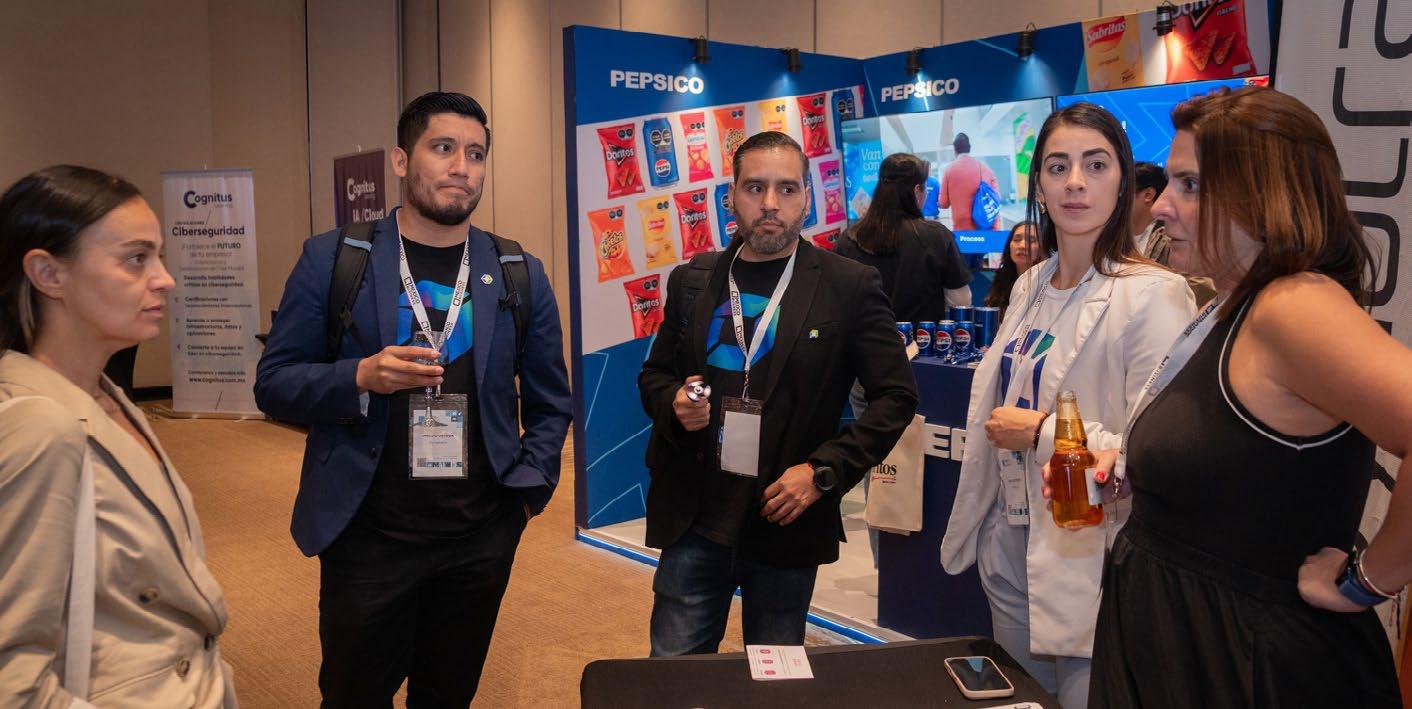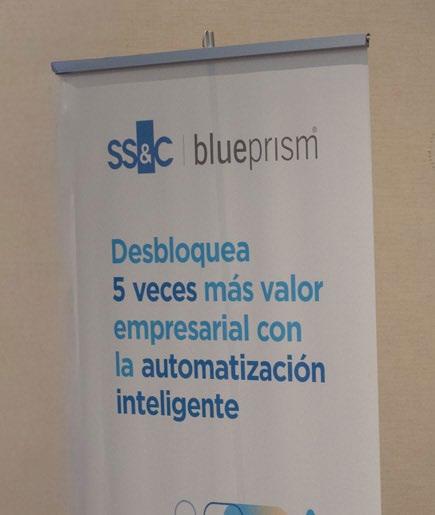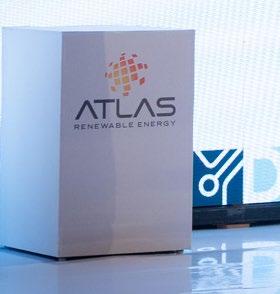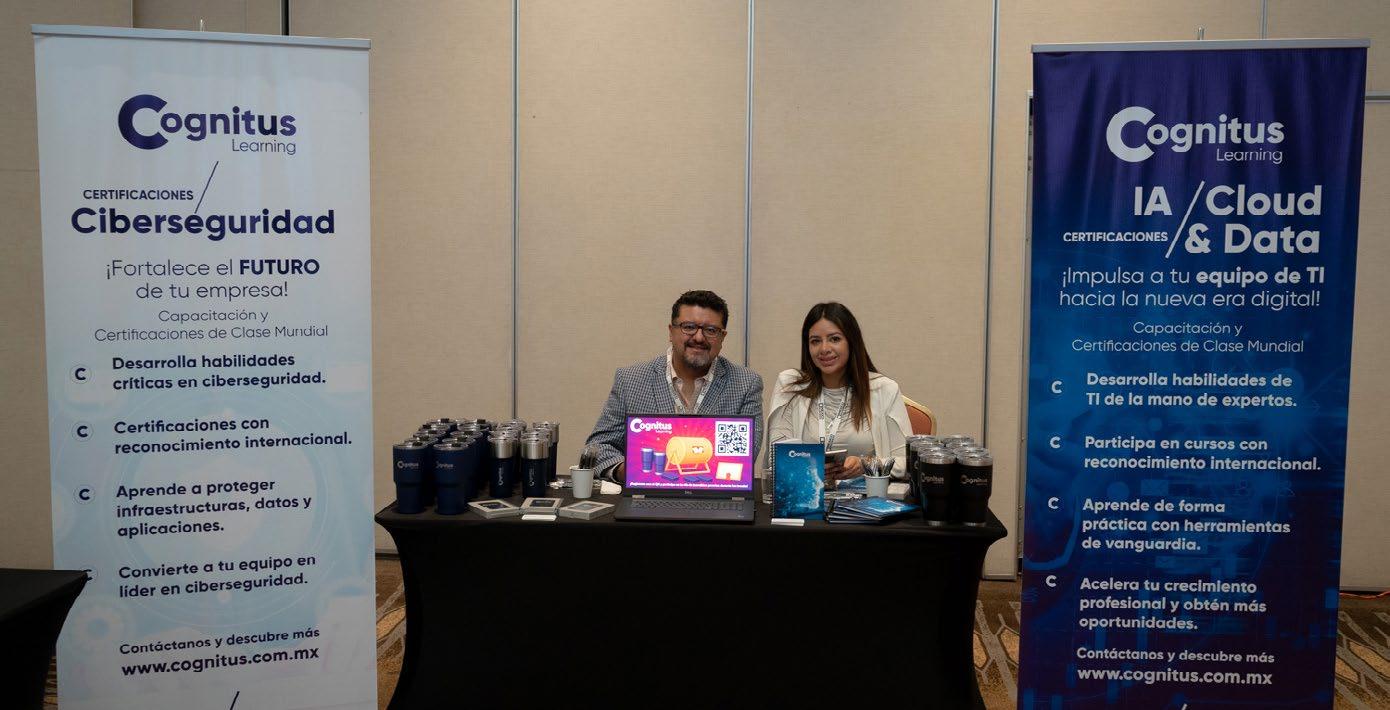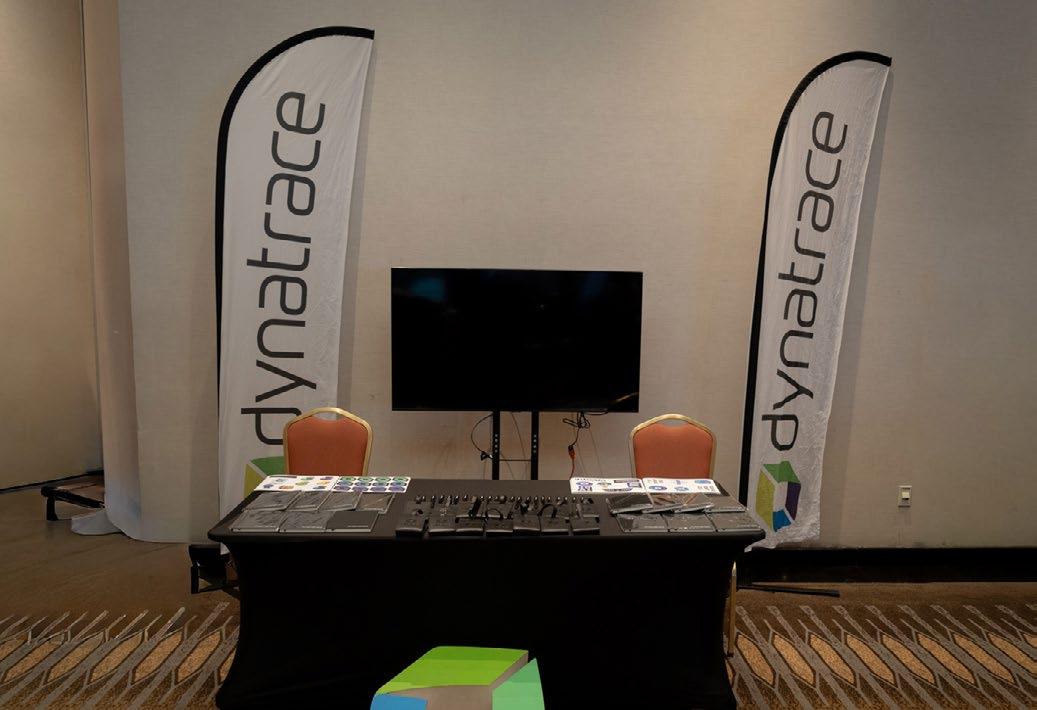Matchmaking
Mexico’s leading B2B conference organizer uses a customized app to deliver an unparalleled experience
The MBE App delivered AI-powered intent-based matchmaking to Mexico AI, Cloud & Data 2025 attendees MBE App Impact
137 participants
388 matchmaking communications
direct pre-conference LinkedIn impressions
pre-conference click through rate
94 1:1 meetings conducted Matchmaking intentions
Total 1,594 1,135 Networking
459 Trading
• 99minutos.com
• AI for Good CDMX Hub
• AI for Good Hub Leader
• Ai for Good Young AI Leaders
• ALAp SI
• Algosec
• Alianza México Ciberseguro
• Alsea
• AMECH
• AMITI
• Area Industrial
• Asamep Asociación
• AS o CIACI o N DE AG r EGAD or ES DE MEDIoS DE pAGo
• Atlas renewable Energy
• B2V Media
• Banco Azteca
• Banco de Credito del peru
• Bankaool, S.A. Institución de Banc a Múltiple
• Banorte
• BBVA
• Becerril, Coca & Becerril
• Bell Technologies Mexico
• Bidf TA.com
• BIopAppEL
• Business Book fair
• Business france
• Cancún IT
• CENACE
• Chevez ruiz Zamarripa
• CICMEX / ATENTUS
• Cluster Aeroespacial
• CNBV
• CoGENEr A
• Cognitus IT
• Co M pLIA
• Conecta
• Conver t Commerce
• Coppel
• Danone
• Desarrolladora del parque, SA de CV
• DESC Corpor ATIVo
• DI r AC SApI de CV
• DoW
• Dylo INC
• Dynatrace
• EdgeUno
• Ekolabs
• El palacio de Hierro
• Equipos y productos Especializados SA de CV
• ESC partners
• Euromundo
• Eutelsat Group
• ferrovalle
• for vis Mazars
• ftech
• GIBH or SMArT SErVICES SAS DE CV
• G rupo Altex
• Grupo BeIT
• Grupo ITS
• GSK
• Heineken
• Hexaware Technologies
• Hostech
• IBH
• iboss
• ICEE de México
• INDIA CHAM BEr MEXICo
• INN oVATI
• International S o S México Emergency Services S de r L de CV.
• INTEr proTECCIÓN
• I pADE BUSIN ESS SCH oo L
• Izzi
• Japan Tobacco International
• Jeen.ai
• Jumex
• Kiritek
• Kueski
• Laboratorios Sophia
• Liva Talent
• Loreal
• Mercado Libre
• Mercado pago
• Metrofinanciera
• Mexico Business
• Microsoft Mexico
• Newmont
• Ngrenta
• Novartis farmaceutica
• N oVArTIS fAr MACÉUTIC A SA DE CV
• Nubiral
• oca Global
• o N ENErGY
• o ne percent finance leaders
• o ntario o ffice in Mexico
• opTIMISSA
• palla financial
• pALo IT
• paradiqma
• pepsiCo
• pernod ricard
• pp G
• pricetravel
• p yramid Consulting, Inc.
• Q MA - iboss
• rUH rpUM pEN
• SABor MEX
• SEG U roS ATLAS
• SENADo DE LA r EpÚBLICA
• Senate of Mexico
• Senior Account Executive
• SIEMENS
• SS&C Blue prism
• SSC
• STp
• Suprema Corte de Justicia de la Nación
• T-Systems
• Tecnológico de Monterrey
• Tequilera de Arandas
• Texas European Chamber of Commerce
• Tr AfALGAr
• Tr MX
• Truper
• TV AZTECA
• Uala
• United states embassy
• Verint
• VoXY
• Weber Shandwick
• X DATA
• yotepresto.com
• Zendesk
• Zoom
TUESDAY, OCTOBER 21
09:00 FROM DATA TO PRINCIPLES: CRAFTING MEXICO’S AI LAW
Speaker: Rolando Zapata, Senate of Mexico
09:30 DATA-DRIVEN MEXICO: TURNING STRATEGY INTO ECONOMIC REALITY
Moderator: Sofia Pérez, AMITI
Panelists: Gabriel Olguín, ppG Industries
Irma Caleti, Japan Tobacco International
Joseph Hernández, Citi
César González, BanBajío
10:40 FROM DASHBOARD TO REAL ACTION: THE NEW ROLE OF AI IN OPERATIONAL AND BUSINESS DECISIONS
Moderator: Carmen Nava, Dynatrace
12:00 THE ROAD FOR MEXICAN COMPANIES TO UNLOCK AI AGENT POTENTIAL
Moderator: Javier Blaustein, Vp Latam, Jeen.ai
Panelists: Jorge Valdes de la O, Grupo Infra Héctor Romero, TV Azteca
Jesús Vázquez, Alcon
Pablo Castillo, izzi
13:00 DATA GOVERNANCE IN AI: THE PILLAR OF RESPONSIBLE AI DEVELOPMENT
Speaker: Manuel O’Brien, AMITI
13:15 POWER DATA CENTERS
Speaker: Daniel García, Atlas renewable Energy
15:00 MULTI-CLOUD MASTERY: ENABLING RESILIENT MANUFACTURING SUPPLY CHAINS
Moderator: Carmen Nava, Dynatrace
Panelists: Alejandro García, La Costeña
Julio Montalván, Novartis
16:00 MASTERING GENERATIVE AI: GOVERNANCE, RISK & CONTROL FOR C-LEVELS
Speaker: Javier Blaustein, Jeen.ai
16:15 LIMITLESS CLOUD: NAVIGATING AI, SECURITY, AND INDUSTRY 4.0
Moderator: Ivonne Mejía, Microsoft Mexico
Panelists: Ivan Guerra, Global Cruises LLC
Luis Martínez, Colgate-palmolive
Víctor Aguilera, Alsea
Pablo Mosqueira, QMA/iboss Mexico
FROM DATA TO PRINCIPLES: CRAFTING MEXIC O’S AI LAW
Mexico’s Senate is advancing a comprehensive effort to regulate and promote AI through a national framework designed to ensure responsible development, ethical use, and technological competitiveness, explains Senator rolando Zapata, president, Senate’s AI Commission.
“This General Law aims to establish, on a horizontal axis, a framework that distributes powers and responsibilities among the federal government, state governments, and municipalities, across different levels of authority, while also fostering the participation of the main stakeholders involved in AI in Mexico,” says Zapata.
The commission, established for the first time in Mexico’s legislative history, is working to create a General Law on AI that would both encourage AI innovation and set clear parameters for its governance. According to Zapata, this initiative aims to balance flexibility, inclusiveness, and ethical standards to keep pace with rapid technological evolution, while fostering Mexico’s growth as a regional AI leader.
Since its formation, the commission has held six forums between December and April, bringing together around 80 experts from the public, private, academic, and social sectors. The results include a consolidated report, complete transcripts of over 300 interventions, and a draft proposal for the legal framework.
This proposal envisions a systematic review of at least 17 existing laws — including those on health, education, data protection, intellectual property, and environmental regulation — to integrate AI-specific considerations.
This process will allow AI principles and standards to be reflected across multiple legal domains, explains Zapata. “We are not seeking to create rigid laws that quickly become obsolete,” he adds. “Instead, we want a flexible framework that establishes principles and values adaptable to technological change.”
The proposed framework acknowledges that AI is a global technology whose infrastructure often lies outside Mexico. Consequently, Zapata emphasizes the importance of aligning national standards with international partners, particularly within North America, to leverage trade agreements and strengthen Mexico’s position in the regional AI ecosystem.
Additionally, the proposal incorporates a structured risk evaluation model inspired by the approach taken by the European Union: classifying AI systems by levels of risk, ranging from unacceptable to minimal, and tailoring oversight accordingly.
Beyond the legal dimension, Zapata stresses the importance of developing a National AI Strategy to define responsibilities for government, private industry, and educational institutions. Key elements of the proposed legislation include principles on ethics and human rights, governance and coordination mechanisms, education and digital literacy, research and technological development, transparency, and accountability. It also calls for the creation of a national authority on AI to oversee implementation and coordination across sectors.
By pursuing this initiative, Mexico seeks to establish itself as a regional leader in ethical and sustainable AI governance, promoting innovation while ensuring that technology serves public interest and national development, explains Zapata.
DATA-DRIVEN MEXICO: TURNING STRATEGY INTO ECONOM IC REALITY
Companies in Mexico face a critical gap between the intent to invest in data and AI and their effective operational execution. Despite a notable increase in projected spending, the country maintains a digital maturity index of only 41.7%, which limits measurable economic impact.
The central challenge is converting data into tangible value. “We often lose sight that to be data-driven is to be value-driven. The most valuable thing is to understand what moves the needle,” said Gabriel olguín, IT LATAM Director, ppG Industries, during the Mexico AI, Cloud and Data Summit 2025. The primary obstacle is not technological acquisition, but rather strategic alignment and organizational implementation capability.
Mexico’s macroeconomic environment presents a compelling case for the accelerated adoption of data-driven strategies. An annual Gross Domestic product (GDp) growth of 1.2% in 2Q25, with only three states exceeding the 4.5% growth target, shows stagnation that traditional business models struggle to overcome.
A 0.7% contraction in secondary activities, which include the manufacturing sector responsible for 21.7% of the national GDp, is another warning sign. In this scenario,
advanced analytics and AI emerge as strategic tools that can enhance corporate resilience. projections indicate that generative AI alone could contribute up to 6.2% of Mexico’s national GD p, positioning digital transformation as an economic imperative.
“The goal is to leverage data to gain deeper business insight, drive informed decisions, and uncover opportunities for growth,” says Sofia pérez, Director General, AMITI.
However, the transition from strategy to execution is hindered by structural, human and strategic factors. The fundamental challenge is not technological but one of leadership, organizational redesign and human capital development.
Digital transformation requires a change in mindset driven from the C-suite. pérez notes the need to develop skills such as curiosity and strategic thinking throughout the staff, not just in technical roles, so that strategic plans permeate the organization.
This approach requires “general digital literacy” within companies. “The technology and analysis areas must be seen as part of the business, not external areas. This cultural promotion enables greater preparation and evolution across
“To close the gap between strategy and economic reality, concerted actions are required. First, public policy that develops a national AI strategy is necessary to provide investment certainty. Second, corporate strategy where C-suite leadership actively drives a data-first culture, linking KPIs to data initiatives”
specialized talent the market demands. “Companies that successfully integrate these analytical capabilities are expected to lead their industries and become the primary architects of Mexico’s future economic competitiveness,” says González.
AMITI
Sofía Pérez Director General |
all organizational areas,” says Irma Caleti, Corporate Systems Americas Director, Japan Tobacco International.
o rganizations also face difficulties integrating diverse sources and managing large data volumes, as they often lack a robust data governance framework. The lack of adequate governance frameworks and a common language are the primary obstacles impeding synergy, says César omar González, Deputy Director of Architecture and Data Governance, BanBajio.
This issue is reflected at the national level. Mexico scores 2.8 out of 100 on the Institutional pillar of the Government AI readiness Index. Joseph Hernández, Mexico Data o ffice Head, Citi, points to the need for a balance between governance and technology, highlighting that data ownership is key, and includes privacy, regulatory frameworks, and protection.
“Data is not just IT’s responsibility; it requires enterprise-wide alignment and a shared data governance culture,” says Hernández.
The problem is exacerbated by a critical shortage of professionals. Up to 70% of companies report difficulty hiring AI specialists, with demand tripling compared to the rest of Latin America. This fact is related to the country’s low r&D investment (0.28% of GD p compared to the o ECD average of 2.72%).
Collaborative investment in human capital among government, academia, and the private sector is required to develop the
Despite the challenges, the application of data strategies is already generating value. In manufacturing, predictive maintenance has resulted in a 10% improvement in production efficiency and a 20%–30% reduction in unplanned downtime since 2023, with estimated annual savings of US$300,000 per plant.
In the financial sector, the separation of Citi and Banamex shows a large-scale data agility exercise, which enabled two banks to operate independently and securely “basically from one day to the next,” says Hernández.
In retail, Comex used data to understand who customers are, why they buy, and which products predominate by store, says olguín. This allowed the company “to provide a tailored offer” to better capitalize on the existing market.
p roprietary technology can also address specific opportunity areas through tools that show executives “day-to-day information to compare” period against period, moving from static reports to specific databases to expand client portfolios, says González.
“To close the gap between strategy and economic reality, concerted actions are required. first, public policy that develops a national AI strategy is necessary to provide
investment certainty. Second, corporate strategy where C-suite leadership actively drives a data-first culture, linking KpIs to data initiatives,” says pérez.
THE NEW ROLE OF AI IN OPERATIONAL, BUSINESS DECISIONS
The digital landscape is rapidly evolving, driven by the adoption of cloud-native platforms and the scaling of AI technologies. According to Gartner, over 95% of new digital workloads are expected to run on cloudnative platforms by 2025, up from 30% in 2021. As organizations accelerate these initiatives, a unified approach to managing complexity, risk, and performance becomes essential, says Carmen Nava, Senior Strategic Enterprise AE, Dynatrace, during the Mexico Business AI, Cloud & Data Summit 2025.
“Digital acceleration has outpaced our ability to manage complexity,” says Nava. “observability is no longer a technical niceto-have; it is the foundation that connects data, AI, and business outcomes.”
f or cloud and AI workloads, effective observability delivers three critical business outcomes:
+ Accelerating Deployments: Speeding up the rollout of cloud-native workloads
+ Ensuring Success and Governance: Supporting AI initiatives while maintaining compliance and control
+ Enhancing Developer Experience: Improving productivity and overall developer satisfaction.
Data alone is not enough; the real challenge lies in integrating it intelligently to generate insights that drive decision-making, automation, and innovation, Nava explains. In multicloud environments, every layer of the technology stack tells a different story. “ o bservability gives you a single, unified narrative — one source of truth that allows leaders to innovate without losing control,” she adds.
AI observability ensures that Generative AI, LLMs, and advanced AI initiatives achieve their intended objectives. Key metrics include total requests, average request duration, costs, and guardrail executions to detect issues such as pII leaks or model toxicity. Beyond infrastructure monitoring, observability is crucial for application performance and enduser experience, explains Nava. Simplifying complex applications eliminates blind spots, enhancing both operational efficiency and business outcomes.
operating AI systems without observability can be similar to “flying a plane without radar,” says Nava. organizations must know where they are headed, identify risks such as toxic prompts or inefficiencies, and ensure that every model is governed and aligned with strategic goals, she adds.
End-to-end observability and security is the final cornerstone, enabling organizations to reduce complexity, optimize costs, and safeguard against threats across modern environments. The unified approach transforms business operations through innovation, risk reduction, and cost savings. It also optimizes cloud and vendor expenditures, while mitigating risk with stronger vulnerability management and compliance.
A consolidated platform delivers real-time insights for executives, continuous compliance for IT teams and SrEs, and automated root cause analysis for engineers. Developers benefit from autonomous intelligence tools like Davis Copilot, which provide guidance
directly in the IDE, resolve root causes, and suggest code fixes to accelerate productivity, reports Dynatrace.
“Technology should enable people, not overwhelm them,” Nava says. “When developers spend less time troubleshooting and more time creating, that is when innovation truly scales.”
Looking ahead, observability is expected to evolve into something far more powerful. “The future of observability is not just visibility — it is intelligence,” says Nava. “When systems can see, understand, and act in real time, organizations gain the confidence to evolve faster than ever before.”
THE ROAD FOR MEXICAN COMPANIES TO UNLOCK AI AGENT POTENTIAL
The adoption of AI in Mexico is accelerating, with 495,000 companies incorporating the technology in the last year. However, this quantitative advance reveals a critical strategic maturity gap that positions the transition to autonomous AI agents as the next significant challenge, and the greatest competitive opportunity for the country’s business sector.
“From a communications perspective, we see this technology as an opportunity to reinvent ourselves. Three advantages stand out: radically optimizing the network, transforming the user experience, and increasing agility to identify and implement new revenue streams”
The Mexican business ecosystem has responded quickly to AI, creating a landscape of widespread but shallow adoption. Amazon Web Services’ (AWS) Unlocking Mexico’s AI potential 2025 report notes that, during 2024, the total penetration rate rose from 29% to 38%, meaning over 2 million companies now use some form of AI. The report points to chatbots (69% adoption) and Generative AI (66%) as the most common tools.
However, this breadth of adoption contrasts sharply with its depth. only 3% of companies in Mexico have reached an advanced stage of implementation. AWS explains that just 7% of companies apply AI to advanced processes, while 72% limit it to basic, isolated uses.
Pablo Castillo Deputy Director of Innovation and Technology
| izzi
“AI is a tool to support business value, automate processes, and optimize resources, but strong governance remains essential,” said Jesús Vázquez, IT Director of the Latin American r egion and AGS Mexico, Alcon, during the Mexico AI, Cloud & Data Summit 2025.
“There is significant hype and misinformation surrounding AI. Its implementation can be risky and create cultural barriers, as expectations are often unrealistic. Nearly 80% of AI projects fail to achieve their intended outcomes,” says Héctor romero, Chief AI officer, TV Azteca.
This superficiality creates a paradox. While 88% of companies report productivity improvements, only 30% have seen significant business benefits. This indicates companies are achieving tactical, task-level
efficiency but are failing to translate those small wins into strategic, business-level value like new revenue streams or significant cost reductions. This gap is the direct consequence of technological adoption that precedes a coherent integration strategy.
The road to AI Agents: A Strategic roadmap
The transition from isolated AI tools to orchestrated autonomous agents represents the next frontier of competitiveness. This leap demands a clear understanding of the opportunities, obstacles, and strategic path forward.
“An AI agent is not a concept that has not been managed for a long time. What is interesting is how it is enhanced by Generative AI, which enables it to make decisions,” says Jorge Valdes de la o, IT Director, Grupo Infra.
Autonomous AI agents are software entities that make decisions and execute complex actions to meet business objectives without direct human intervention. Their impact could be transformative across Mexico’s key sectors.
In the manufacturing and automotive industries, agents can enable predictive maintenance to reduce downtime, use
computer vision for superior quality control, and dynamically optimize supply chains. An analysis by McKinsey shows that AI at this scale can increase productivity by two to three times and reduce defects by up to 99%.
In financial and tax services, AI agents can be critical for efficiency and compliance within the Tax Administration Service (SAT) framework. They can automate real-time fraud detection and manage complex tax reconciliations, mitigating compliance risks, and freeing human capital for high-value strategic planning.
The communications sector is also leveraging this technology. “ f rom a communications perspective, we see this technology as an opportunity to reinvent ourselves. Three advantages stand out: radically optimizing the network, transforming the user experience, and increasing agility to identify and implement new revenue streams,” says pablo Castillo, Deputy Director of Innovation and Technology, izzi.
Identifying the fundamental obstacles
Despite this potential, several interconnected obstacles hinder large-scale adoption in Mexico. The primary bottleneck is a human capital deficit. A Bain & Company survey reports that 56% of companies cite a lack of talent as the main barrier to adoption, a problem compounded by a knowledge gap at the executive level.
“Infrastructure and talent represent significant areas of opportunity in Mexico when it comes to implementing this technology,” explains Vázquez.
This is reinforced by cultural and strategic inertia. An analysis by IpADE Business School underscores that the core issue is not a lack of technology, but the absence of a clear integration strategy from leadership. This is coupled with technical and data governance hurdles, as integrating new AI with legacy systems is complex, and concerns over data quality, bias, and privacy are paramount for effective and ethical implementation. finally,
a nascent regulatory framework for AI creates legal uncertainty, making companies hesitant to commit to long-term investments.
These challenges create a vicious cycle: a lack of strategic vision prevents investment in talent and the skills shortage leads to poor AI implementation. These issues lead to a failure in generating significant roI, which reinforces leadership’s skepticism and inaction.
A Strategic Guide for Business Leaders
Breaking the cycle of low maturity requires a deliberate roadmap focused on building organizational capabilities, not just acquiring technology. Companies would benefit from an approach that prioritizes strategy over the tool. This would involve the development of a formal AI strategy aligned with core business objectives.
“Every company has different departments, cultures, and levels of expertise. It is important to listen to diverse perspectives, as they can lead to replicable solutions,” says Javier Blaustein, Vice president Latam, Jeen.ai.
Another suggestion is investing in human capital, and treating workforce training as a strategic investment. This requires robust upskilling and reskilling programs focused on both technical skills and complementary human skills like critical thinking. robust data governance is also essential. This can be achieved through the establishment of a transparent framework for data collection, use, and privacy.
from Automation to Autonomy
The AI landscape in Mexico is at a crossroads. While basic tool adoption is widespread, true competitive advantage will come from scaling to the next phase: autonomous AI agents. This future paradigm, where agents execute complex business objectives independently, is expected to profoundly redefine industries.
Companies that fail to build the necessary strategic, cultural, and data governance foundations risk becoming structurally unable to compete in the coming era of autonomous automation. The path to unlocking this potential does not begin with new technology, but with the leadership commitment to transform the organization from within.
DATA GOVERNANCE IN AI: THE PILLAR OF RESPONSIBLE AI D EVELOPMENT
AI governance has emerged as the fundamental pillar for the responsible development of AI. Amid their accelerated business integration, implementing ethical and operational frameworks is essential to mitigate the risks inherent in deploying AI systems, explains AMITI.
The reliability of these systems depends on their training quality, explains Manuel
o ’Brien, Leader of the AI and Emerging Technologies Committee, AMITI. “Your AI will only be as good as the data with which you train it,” says o’Brien. for that reason, rigorous oversight and robust governance architecture should be established from the design phase.
The dominant AI paradigm now centers on f oundation Models. These Generative AI
models are built on transformer architecture designed to generate data sequences. They are trained with vast multimodal datasets, including text, images, speech, and structured data, to execute a wide range of tasks.
The adoption of these models has been fast. “By 2025, nearly 70% of AI research involves models of this type,” says o’Brien. However, their adoption introduces significant risks, including accountability, inherent bias, and the difficulty of explainability, which often results in “black box” systems.
“The social and ethical challenges posed by AI are increasingly visible in public debates around privacy, bias, and accountability,” says o’Brien.
These issues have led to serious failures with severe consequences. for example, algorithmic bias became a public issue in 2020 in the United Kingdom, where an algorithm used for student grades sparked protests over an unfair system that perpetuated class biases. That same year, the Gender Shades project revealed structural biases in facial recognition. That study found these algorithms consistently showed the poorest accuracy for darker-skinned women, with error rates reaching 34.4% for IBM, 33.7% for face++, and 20.8% for Microsoft.
r ecent models continue to struggle with veracity. A Newsguard Tech report issued
in August 2025 on false information in LLM responses showed concerning rates for Inflection (56.67%), p erplexity (46.67%), Meta (40%), and Copilot (36.67%).
The formalization of AI governance could help to address these problems, with large institutions like JpMorgan Chase and global policy think tanks actively shaping standards. “AI governance has become a geopolitical discussion,” says o’Brien.
o’Brien outlines five core ethical principles organizations must embed in AI governance:
1. Explainability: Ensuring AI systems provide human-interpretable reasoning for predictions and outcomes.
2. fairness: Guaranteeing equitable treatment of individuals and groups, with sensitivity to application context.
3. robustness: Building resilient systems capable of handling anomalies or irregular inputs.
4. Transparency: Disclosing how models are designed, developed, and deployed.
5. privacy: Safeguarding user data and prioritizing privacy rights throughout AI processing.
These principles are being codified into regulations, explains o’Brien. The European Union has been a pioneer with the General Data p rotection r egulation (GD pr ) and the AI Act. The latter applies a risk-based approach, classifying risks as:
+ Unacceptable: prohibited systems, such as real-time biometric surveillance.
+ High: Systems in critical sectors (for example, recruitment or healthcare) requiring strict compliance.
+ Limited: Systems with transparency obligations, such as customer service chatbots.
+ Minimal: Systems like video game AI, subject to voluntary codes of conduct.
practical implementation requires organizations to define accountability, transparency (who participates in testing), and explainability (how model answers are explained).
“In corporate settings, AI deployment success increasingly depends on governance readiness. Transparent data handling, well-
defined roles, and robust model oversight have become both ethical imperatives and competitive differentiators,” says o’Brien.
SUSTAINABLE ENERGY: AN IMPERATIVE NEED TO POWER DATA CENTERS
The Latin American data center market is experiencing accelerated growth, surpassing initial projections from market intelligence firms, explains Atlas r enewable Energy. However, this rapid growth faces significant systemic challenges, particularly in Mexico.
“The Mexican electrical system faces complications,” says Daniel García, Commercial Director, Atlas r enewable Energy. “Today the system is saturated.”
Atlas r enewable Energy’s internal assessments indicate that IT load capacity in Latin America is forecasted to reach 3,160MW by 2029, an increase of 1,197MW (61%) over Mordor Intelligence’s forecast for the same period. This reflects a market expansion that is outpacing previous expectations.
Meanwhile, Mexico’s minimum reserve margin, a key indicator of reliability, declined from 13.40% in 2021 to a projected 3.60% in 2024. This exacerbates the risks associated with new data center developments. “Consumers face difficulties connecting to the system and obtaining competitive solutions, which require new investments, long-term contracts, and strategic planning,” says García.
Certain states, such as Queretaro, lead the country in required investment per megawatt of installed capacity. “In Queretaro, determining the most expensive zones for connection clearly shows the problem,” says García.
International data center operators have struggled to secure reliable electricity access in Mexico, particularly for 24/7 supply with flexible ramp-up capabilities. Agreements with generation companies often come with unfeasible timelines, and interconnection difficulties affect the availability of
competitive p ower p urchase Agreements ( ppAs, says García. “The main barriers to connecting to the electrical system include competitive energy and service expectations that are not always met. If there is no solution, companies do not even want to discuss the issue,” he adds.
o vercoming these challenges requires expertise in navigating local regulations, financing, and grid constraints. “More than talking about what data centers can do, we focus on supporting them with specific solutions that provide certainty: contracts, supply, access to infrastructure, land, and capacity,” says García.
Atlas r enewable Energy positions itself as a strategic enabler for hyperscalers and colocation partners, offering a fully integrated, one-stop-shop solution. The company leverages its expertise across the entire data center value chain:
+ power Infrastructure Development: Guarantees interconnection availability and develops DC power infrastructure, “a critical step that typically takes one year,” says García.
+ Competitive renewable Energy Supply (ppA): offers competitive renewable energy solutions across Latin America with a 1.5GW portfolio, including hedging, ramp-up flexibility, and Battery Energy Storage Systems (BESS). The supply start date typically requires two years.
+ Site and Shell Development: provides site development tailored to client requirements, including access to load connections, and, where needed, the construction and operation of a powered shell or full infrastructure.
This integrated approach ensures that data centers have the reliable, renewable energy supply required to sustain the region’s
technological growth, while also mitigating risks associated with grid access, investment timelines, and regulatory complexity.
The long-term trend points toward integrated partnerships, where energy providers, data center developers, and real estate partners collaborate to accelerate deployment and secure reliable supply. Atlas renewable Energy aims to be the leading energy partner in Latin America, delivering fully integrated solutions across Brazil, Chile, Mexico, peru, and Colombia.
By combining renewable energy ppAs, power infrastructure development, and close collaboration with colocation partners, the industry can shorten the critical path to Data Center Commercial o peration Date, says García. “renewable energy is the only option that can offer competitive prices in Mexico. The industry must think about how to turn the complexity of the electrical system into a solution, not a problem,” says García.
MULTI-CLOUD MASTERY: ENABLING RESILIENT SUP PLY CHAINS
Mexico’s manufacturing sector is experiencing rapid growth driven by nearshoring, but rising cyber threats are testing its resilience. Multi-cloud architecture is emerging as a strategic solution, enabling companies to diversify infrastructure, ensure continuity, and strengthen data security.
“ o perational resilience is no longer an objective; it is a necessity that lies in the multicloud. In a manufacturing environment,
the supply chain already involves multiple countries and suppliers, making a multicloud framework essential,” said Carmen Nava, Senior Strategic Enterprise AE, Dynatrace, during the Mexico AI, Cloud and Data Summit 2025.
The convergence of nearshoring with the adoption of Industry 4.0 technologies has transformed Mexican manufacturing into the prime target for cybercrime. In
this high-reward-high-risk environment, operational resilience is no longer a competitive advantage; it has become a business imperative. Thus, the multicloud architecture emerges as a strategic foundation for survival and sustainable growth.
The perfect Storm: opportunity and risk in Manufacturing
The current landscape is a direct result of the post-pandemic logistics crises. The disruptions that began in 2021, from semiconductor shortages to port paralysis, exposed the critical vulnerabilities of just-in-time production models and the excessive reliance on geographically concentrated suppliers.
“During the pandemic, controls had to be implemented rapidly to ensure operational continuity and protect employees, highlighting the critical support provided by vendors,” says Julio Montalván, Director of Data, Digital, and IT of Mexico, Colombia, and the ACC Cluster, Novartis.
The global response was a massive movement toward regionalization, with Mexico as one of its main beneficiaries. In 2023, the country attracted over US$36 billion in foreign direct investment ( f DI), according to Mexico’s Ministry of Economy.
Key subsectors like automotive and electronics project robust growth.
Nonetheless, this accelerated growth is pushing the country’s infrastructure and human capital to the limit. This situation is turning Mexican manufacturing into a
“Operational resilience is no longer an objective; it is a necessity that lies in the multicloud. In a manufacturing environment, the supply chain already involves multiple countries and suppliers, making a multi-cloud framework essential”
Carmen Nava Senior Strategic Enterprise AE | Dynatrace
prime target for cybercrime. According to Kaspersky, in 2024, manufacturing surpassed others traditionally attacked like the financial or government sectors, becoming the most besieged in the country.
Multi-Cloud: The pillar of Modern resilience
Multi-cloud architecture could be a strategic answer to this problem. A multi-cloud strategy, which involves the combined use of services from two or more cloud providers, enables companies to persist, adapt, and transform in the face of disruption. Just as companies diversify their physical suppliers to mitigate risks, they must diversify their digital infrastructure to prevent a failure in a single cloud provider from completely paralyzing their operations.
“Adopting a multicloud strategy ensures future independence from any single provider, ” says Montalván.
Implementing a multi-cloud strategy is only the first step. True mastery lies in managing its inherent complexity, which requires unified governance that addresses a “trilemma” of interconnected challenges: costs, data, and compliance.
“The cloud will not necessarily be cheaper, but it will provide a significant boost in efficiency if managed properly,” says Alejandro García, IT Director, La Costeña.
Without financial discipline the flexibility of the cloud can lead to uncontrolled spending. This is where f in o ps, a framework that introduces financial accountability into the cloud’s variable spending model, comes into play. It aligns technology, finance, and business teams to make value-based decisions.
In parallel, the value of Industry 4.0 is realized through the integration of real-time data from multiple sources, such as E rp systems and IoT sensors. In a multi-cloud environment, these systems can operate in silos, hindering analysis. The solution lies in creating a unified data fabric through
ApIs and streaming platforms, allowing for end-to-end visibility, a true supply chain “control tower.”
The road Ahead: from Technology to Business Strategy
The adoption of a multi-cloud architecture has transcended the IT department to become a strategic decision for senior management. As the CI o ’s role in manufacturing evolves from infrastructure manager to business resilience architect, data-driven decision-making becomes central to competitiveness.
“By collecting all the data from a production line and transferring it to the cloud, it becomes possible to analyze the information and support decision-making,” says García.
Looking forward, a robust multi-cloud foundation could be the platform on which the next waves of innovation will be built. f or Mexico’s manufacturing companies, mastering multi-cloud is not just a technological option; it is a path to capitalize on the opportunities of nearshoring and build the resilient supply chains that the new economic era demands.
MASTERING GENERATIVE AI: GOVERNANCE, RISK, CONTROL FO R C-LEVELS
The rapid rise of Generative AI has created an omnipresent technological assistant that is increasingly penetrating everyday life and becoming critical in the corporate environment. However, this explosion of AI tools has introduced a major challenge for businesses: fragmentation. o rganizations are now managing dozens of specialized AI platforms and subscriptions, each competing for attention and driving up both costs and complexity.
“This chaotic scenario for corporate AI is unsustainable, exposing businesses to significant financial and operational risks,” said Javier Blaustein, Vice president Latin America, Jeen.ai, during the Mexico AI, Cloud & Data Summit 2025. for C-level executives, success in the AI era depends on mastering three critical, interconnected elements: governance, risk, and control.
Governance defines the rules, access, and policies for AI use. This responsibility primarily falls to the Chief Technology o fficer (CTo ) and the Chief Innovation o fficer (CIn o). Implementation involves establishing role-based controls, setting up approval workflows, and centralizing knowledge access.
r isk sets boundaries by identifying and mitigating data, compliance, and misuse
risks. This function is overseen by the Chief risk officer (Cro) and the Chief financial officer (Cfo). Mitigation strategies include ensuring on-premise execution, preventing data leaks, and actively monitoring prompts.
Control ensures accountability through audits, performance measurement, and traceability mechanisms. The Chief Information Security o fficer (CIS o) and Chief Compliance o fficer (CCo) lead this area. practical measures include maintaining audit logs, creating compliance dashboards, and managing user access.
Consequences of
fragmentation
and Shadow AI
“Without a centralized strategy, companies face several escalating challenges. Shadow AI is a major concern, with more than 70% of organizations reporting that employees use Generative AI tools without official authorization,” says Blaustein. “ o ften, employees rely on personal accounts on platforms like ChatG p T instead of using sanctioned corporate solutions such as Copilot. This creates a dangerous gap characterized by a lack of control, governance, and corporate intelligence.”
Additionally, the cost and complexity of ApIs pose a significant financial risk. Directly using commercial AI A p Is for integration is possible, but usage is typically charged per request, effectively giving every employee a “blank check.” Managing these variable and unpredictable costs requires substantial investment in in-house software, architecture, and dedicated development and finance teams, says Blaustein.
Hallucinations and loss of trust represent another threat. AI models can produce incorrect or fabricated data that can lead to flawed decisions and legal risks. Such failures erode confidence in corporate AI solutions within the company.
from fragmented Tools to Unified Corporate AI platforms
Despite the challenges, properly applied AI tools can simplify processes and bring numerous benefits to organizations. for example, Jeen.ai worked with a financial
“Often, employees rely on personal accounts on platforms like ChatGPT instead of using sanctioned corporate solutions such as Copilot. This creates a dangerous gap characterized by a lack of control, governance, and corporate intelligence.”
Javier Blaustein Vice President Latin America | Jeen.ai
services and credit card issuer with 2,000 employees and US$1 billion in annual revenue that faced several key challenges. These included the manual, error-prone extraction of data from complex documents, slow, resource-intensive credit approval processes, and the risk of using cloud-based AI for highly sensitive documents, says Blaustein.
To address data extraction, a multi-agent AI system was implemented to automate information extraction and structure financial data, says Blaustein. This solution included internal dashboards for traceability and auditing, achieving 95% processing accuracy and a 90% reduction in processing time, with 100% traceability.
f or credit approvals, an intelligent automation system integrated with the company’s C r M. This system analyzes business parameters, evaluates risk, and justifies every decision with auditable criteria, strengthening governance and control.
To mitigate risks associated with “Shadow AI” and sensitive data, a secure, on-premise enterprise chat environment was deployed, says Blaustein. This provided access to advanced LLMs and specific AI agents while ensuring full traceability of queries and auditable agents. These case studies illustrate a shift away from fragmented tools toward unified corporate AI platforms, unifying all AI models, centralizing costs, and enabling management by teams within a secure environment.
Architecturally, this involves creating a central hub that integrates with various AI models (such as Gemini, Anthropic, and Llama) and internal corporate systems (such as SAp, Salesforce, and HubSpot).
To manage the “blank check” risk of A p I usage, a “finops” module is essential. This provides granular control over AI expenditure by establishing wallets per employee, team, or project, and setting defined monthly token quotas. This system allows for detailed reporting on usage and performance and reduces waste from excessive use.
An administrative module provides total organizational control. This allows administrators to configure access at the individual or team level, define which AI models are available, and manage permissions for specific features, sub-features, or AI agents.
f inally, to combat hallucinations, such platforms utilize a suite of r etrievalAugmented Generation ( r AG) agents and “Guardrails.” These tools ensure the AI operates using only internal, verified data sources. “This allows for the creation of customized AI agents for different functions that are programmed to execute
tasks and respond based only on company knowledge,” says Blaustein. “Complex automation flows can be built and audited at every stage for full traceability.”
r ecognizing the sensitivity of corporate data, platforms increasingly prioritize f lexible Deployment and are designed for regulated environments. Deployment options include private cloud, hybrid, or 100% on-premise (air-gapped) execution. This approach ensures full control over data processing and security, allowing organizations to dictate precisely what data leaves their environment, says Blaustein.
LIMITLESS CLOUD: NAVIGATING AI, SECURITY, AND
The fourth industrial revolution has become a present-day imperative. However, as large corporations capitalize on the convergence of cloud computing, AI, and the Internet of Things (IoT), a growing implementation gap threatens to leave behind the bulk of the industrial sector, which faces systemic barriers in cost, talent, and cybersecurity.
“There is a fascinating outlook for cloud adoption in Mexico. This is not a recent conversation; it has been developing for years,” says Ivonne Mejía, Strategic Accounts Sales Director, Microsoft Mexico. She adds that hybrid and public cloud models already show around 70% combined adoption in the country, representing billions of dollars for the economy. “The realization of value and
time-to-market are crucial, as that is where we connect the value the cloud brings to organizations,” she adds.
The core of the challenge lies in the friction between technological vision and operational reality. This gap materializes in concrete technical challenges that slow adoption, such as lack of interoperability between proprietary platforms, compatibility issues with legacy equipment that cannot connect to the new digital infrastructure, and the persistence of data silos that fragment information and hinder decision making.
“We are living in an era where the fourth industrial revolution is defined by interconnectivity,” says Iván Guerra, IT Director, Global Cruises LLC.
“Digital technologies, devices, and systems are merging, creating a hyperconnected ecosystem operating in real time, which generates enormous amounts of data for immediate decision making. This, however, widens the spectrum of vulnerability, and the cloud plays a strategic role in addressing it.”
“We are seeing the integration of generative AI with the cloud to accelerate optimization and detect anomalies. The cloud, along with innovations such as encryption and predictive risk models, will enable Industry 4.0 to be safer and more efficient”
Pablo Mosqueira Director and Strategic Partner
|
QMA/iboss Mexico
infrastructure that enables scalability and massive data processing. However, this rapid technological expansion is not evenly distributed. While large enterprises have the resources to invest and experiment, SMEs face several obstacles slowing down adoption.
The cloud acts as a flexible and secure platform that enables organizations to innovate, yet also requires new forms of financial and operational alignment. “Moving to the cloud is easy from a technical standpoint, but we must also consider the financial and operational implications,” says Guerra.
These integration obstacles are not trivial; they represent a systemic barrier that prevents many organizations, especially SMEs, from fully capitalizing on the promised benefits of increased flexibility and efficiency. Despite advances, “only 12% of SMEs in Mexico have begun their digital transformation, and the same percentage actively considers cybersecurity in their strategy,” says Mejía.
The drive toward industrial digitization is driven by exponential market growth. The global Industry 4.0 market, valued at US$146.14 billion in 2022, is projected to reach US$627.59 billion by 2030. This advancement is catalyzed by underlying technologies such as AI, whose market is expected to soar from US$279.22 billion in 2024 to nearly US$3.5 trillion by 2033.
At the center of this transformation is the cloud, which functions as the foundational
“The cloud helps centralize data, which is fundamental when developing disruptive solutions,” says Luis Arturo Martínez, Senior Director of Information Technology, Colgatep almolive. He adds that centralized data enables innovations such as digital twins for process optimization, but also introduces new risks. “An interconnected industry involves hundreds of thousands of devices connected to the cloud — many of which lack proper security standards. Increased connectivity means a higher number of potential entry points for cyberattacks,” he warns. Martínez highlights the importance of building a culture of shared responsibility: “We must evangelize technology teams alongside business leaders. If the people operating the systems do not understand the financial and operational implications, each cloud action represents a cost.”
The transition to Industry 4.0 is not a simple technology upgrade but a complex business transformation that presents interconnected challenges. f inancial constraints, talent shortages, and cybersecurity threats form a triple barrier that organizations must overcome.
“Cybersecurity is both the name of the game and the name of the cost,” says Víctor Aguilera, CI o , Alsea. Even the most advanced systems depend on a strong security culture, he adds. “Many organizations still see cybersecurity as IT’s responsibility, when in reality it belongs to every process and business area.”
As companies face increasingly sophisticated cyberthreats, the need for built-in, proactive security models becomes urgent. “The cloud is the engine of the new industrial revolution,” says pablo Mosqueira, Director and Strategic partner, QMA/iboss Mexico. “Cybersecurity must be designed from the architecture, not added as an afterthought. In Industry 4.0, the concept of a defined perimeter no longer exists — everything is interconnected through IT and cloud models, fundamentally changing risk structures.”
overcoming the challenges of Industry 4.0 requires not only technological innovation but also new business models, collaborative strategies, and open dialogue among technologists, industry leaders, and regulators.
“We are seeing the integration of generative AI with the cloud to accelerate optimization and detect anomalies. The cloud, along with
innovations such as encryption and predictive risk models, will enable Industry 4.0 to be safer and more efficient,” says Mosqueira.
Adaptability and culture remain central. “AI will change the way we work and operate. o ur work will transform and evolve; of course, we can choose how to adapt. We must learn to change and grow alongside AI,” says Aguilera.
practical implementation is equally critical. “Today it is much clearer; general directors are talking about AI, and the purpose is starting to become understood. What is still missing is the ‘how.’ At Microsoft, we identify three stages: first, using generative AI for consultations without generating concrete actions; next, humans working alongside agents, combining human and AI capabilities; and finally, becoming a ‘manager of agents,’ where work transforms rather than disappears,” says Mejía.
Successful Industry 4.0 adoption blends intelligent cloud-based systems, resilient cybersecurity, and empowered people. organizations that align technology, talent, and strategy will unlock the full potential of AI, IoT, and cloud innovations, while navigating the complexities of the modern industrial landscape. “The key to success is democratizing and empowering the organization, because technology leaders alone cannot achieve it,” says Mejía.









